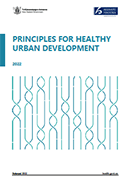
Summary
The urban environment is a determinant of health and wellbeing. Our vision for healthy urban development is pae ora – healthy futures. We have identified four inter-related principles to consider in urban development processes to achieve pae ora and achieve thriving outcomes for our communities. The principles are:
- healthy, safe and resilient communities
- wai ora – healthy environments
- equity
- climate change mitigation and adaptation.
In this paper, we discuss the principles for healthy urban development and its connections with health, wellbeing and equity. We also describe how good urban design can protect and promote health, and improve health, equity and disability outcomes.
With around 84 percent of New Zealanders living in urban areas, our urban environments are where most of us also work, learn and play (EHINZ 2021; WHO 2021b). We thrive when these environments support our health, safety and wellbeing. The recent COVID-19 pandemic has highlighted how the environment is connected to human health and wellbeing.
Urban development that supports health, wellbeing and equity gives people equitable access to healthy housing, safe and active transport choices, good-quality air and water, natural environments and essential services like education, health care, food security, retail, employment opportunities and recreational facilities. Māori communities thrive when they are supported to continue traditions and culture, including through access to mahinga kai, māra and maramataka, and mātauranga Māori approaches to planning and design.
